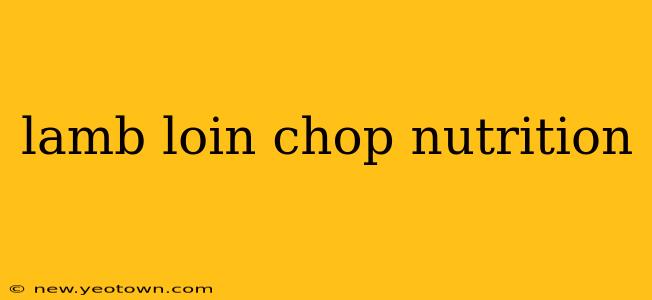The aroma of sizzling lamb, the juicy tenderness of a perfectly cooked chop – lamb loin chops offer a culinary experience that's hard to resist. But beyond the delightful taste, lies a question many health-conscious individuals ponder: what's the nutritional profile of this delectable cut of meat? Let's dive into the details and explore the nutritional benefits and potential drawbacks of incorporating lamb loin chops into your diet.
Our culinary journey begins with understanding the nutritional powerhouse that is the lamb loin chop. It’s a leaner cut compared to other lamb options, making it a relatively healthier choice. But "relatively" is key here – let's unpack the specifics.
What are the nutritional benefits of lamb loin chops?
A typical 3-ounce serving of lamb loin chop packs a nutritional punch, boasting impressive amounts of protein, essential vitamins, and minerals. This makes it a fantastic addition to a balanced diet. Let's look at some key components:
-
High-Quality Protein: Lamb is an excellent source of complete protein, meaning it contains all nine essential amino acids our bodies can't produce on their own. Protein is crucial for building and repairing tissues, supporting immune function, and maintaining overall health.
-
Rich in B Vitamins: Lamb is a treasure trove of B vitamins, including vitamin B12, niacin, and riboflavin. These vitamins play vital roles in energy production, nerve function, and red blood cell formation. A deficiency in B vitamins can lead to fatigue, nerve damage, and anemia, underscoring the importance of including B-vitamin rich foods in our diets.
-
Good Source of Iron: Lamb is a particularly good source of heme iron, the type of iron most readily absorbed by the body. Iron is essential for carrying oxygen throughout the body and preventing iron-deficiency anemia.
-
Essential Minerals: Beyond iron, lamb also provides a decent amount of zinc, selenium, and phosphorus, all of which are vital for various bodily functions. Zinc supports immune function and wound healing, selenium acts as an antioxidant, and phosphorus is crucial for bone health and energy production.
How many calories are in a lamb loin chop?
The calorie count of a lamb loin chop can vary depending on the size of the chop and the cooking method. However, a 3-ounce serving typically contains around 200-250 calories. This calorie range can make it a suitable part of a weight-management diet, especially when prepared with healthy cooking methods, like grilling or baking, instead of frying.
Is lamb loin chop good for weight loss?
While a single lamb loin chop isn't inherently bad for weight loss, it's essential to consider the entire meal and your overall calorie intake. Because lamb is relatively high in fat, portion control is crucial. Pairing your lamb loin chop with a generous serving of vegetables and limiting added fats during cooking can contribute to successful weight management.
What are the downsides of eating lamb loin chops?
Despite its nutritional benefits, it’s important to acknowledge potential downsides:
-
Higher in Fat than some other proteins: Compared to chicken breast or fish, lamb contains more fat, particularly saturated fat. While moderate amounts of fat are necessary, excessive saturated fat intake can contribute to high cholesterol and heart disease.
-
Potential for high cholesterol: The relatively high saturated fat content can elevate cholesterol levels in some individuals. Those with high cholesterol should monitor their lamb consumption.
-
Cost: Lamb is generally more expensive than other protein sources.
How to prepare lamb loin chops healthily?
Preparing lamb loin chops healthily involves minimizing added fats and maximizing flavor through herbs and spices. Grilling, baking, or broiling are healthier cooking methods compared to frying. Marinating the chops before cooking can also add flavor and tenderness.
In conclusion, lamb loin chops can be a delicious and nutritious part of a balanced diet. However, mindful consumption, portion control, and healthy cooking methods are key to reaping its benefits while minimizing potential drawbacks. Remember to consult with a healthcare professional or registered dietitian to determine how lamb fits into your individual dietary needs.

